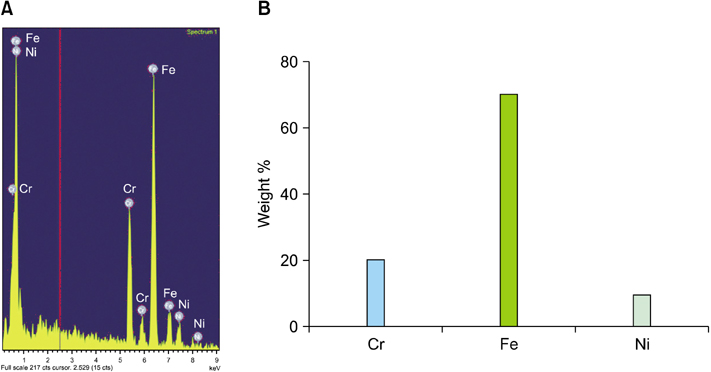Ann Dermatol.
2013 May;25(2):152-155. 10.5021/ad.2013.25.2.152.
The Fine Scratches of the Spectacle Frames and the Allergic Contact Dermatitis
- Affiliations
-
- 1Department of Dermatology, College of Medicine, Chung-Ang University, Seoul, Korea. beomjoon@unitel.co.kr
- 2Medical IT Convergence Research Center Korea Electronics Technology Institute, Seoul, Korea.
- 3Department of Pediatrics, Samsung Changwon Hospital, School of Medicine, Sungkyunkwan University, Changwon, Korea.
- KMID: 2171781
- DOI: http://doi.org/10.5021/ad.2013.25.2.152
Abstract
- BACKGROUND
Spectacle contact allergy is not infrequent. The fine scratches on the spectacle frames which may play a role in the sensitization to the potential allergenic components have not been studied.
OBJECTIVE
We sought the relationship between the scratches on the spectacle frames and the allergic contact dermatitis (ACD) in the Republic of Korea.
METHODS
A total of 42 Korean patients with ACD at the spectacle contact sites were enrolled. Their spectacle frames were examined with the dimethylglyoxime (DMG) test and analyzed by the scanning electron microscopy (SEM) and energy-dispersive X-ray spectroscopy (EDS). Patch tests (thin-layer rapid use epicutaneous test [TRUE tests]) were performed to identify the skin allergens.
RESULTS
The DMG-positive spectacle frames were identified in 78.5% of the frames. The SEM results showed that there were more scratches on the skin-contacting parts of the spectacle frames than the non-skin-contacting parts of the same frames. In the EDS findings, the mean nickel content (weight, %) of the spectacle frames was 15.7+/-5.5, and the mean chromium content was 20.3+/-3.4 at the skin-contacting parts. In the TRUE tests, nickel sulphate was the most common allergen (31 cases, 73.8%), and potassium dichromate was the second (9 cases, 21.4%). Three patients presented simultaneous positive reactions with nickel sulphate and potassium dichromate.
CONCLUSION
Minor visible and non-visible fine scratches on the spectacle frames may present the provocation factors of the ACD. Nickel sulphate was the most common allergen suspected of provoking the spectacle frame-induced ACD, followed by potassium dichromate.
MeSH Terms
Figure
Reference
-
1. Thyssen JP, Johansen JD, Menné T, Nielsen NH, Linneberg A. Nickel allergy in Danish women before and after nickel regulation. N Engl J Med. 2009. 360:2259–2260.
Article2. Thyssen JP, Jensen P, Johansen JD, Menné T. Contact dermatitis caused by nickel release from hair clasps purchased in a country covered by the EU Nickel Directive. Contact Dermatitis. 2009. 60:180–181.
Article3. Thyssen JP, Maibach HI. Nickel release from earrings purchased in the United States: the San Francisco earring study. J Am Acad Dermatol. 2008. 58:1000–1005.
Article4. Girolomoni G, Gisondi P, Ottaviani C, Cavani A. Immunoregulation of allergic contact dermatitis. J Dermatol. 2004. 31:264–270.
Article5. Walsh G, Wilkinson SM. Materials and allergens within spectacle frames: a review. Contact Dermatitis. 2006. 55:130–139.
Article6. Fisher AA. Contact dermatitis. 1967. Philadelphia: Lea & Febiger.7. Menné T, Andersen KE, Kaaber K, Osmundsen PE, Andersen JR, Yding F, et al. Evaluation of the dimethylglyoxime stick test for the detection of nickel. Derm Beruf Umwelt. 1987. 35:128–130.8. Ivens U, Serup J, O'goshi K. Allergy patch test reading from photographic images: disagreement on ICDRG grading but agreement on simplified tripartite reading. Skin Res Technol. 2007. 13:110–113.
Article9. Sun CC. Allergic contact dermatitis of the face from contact with nickel and ammoniated mercury in spectacle frames and skin-lightening creams. Contact Dermatitis. 1987. 17:306–309.
Article10. Ruff CA, Belsito DV. The impact of various patient factors on contact allergy to nickel, cobalt, and chromate. J Am Acad Dermatol. 2006. 55:32–39.
Article11. Walsh G, Mitchell JW. Free surface nickel in CE-marked and non-CE-marked spectacle frames. Ophthalmic Physiol Opt. 2002. 22:166–171.
Article
- Full Text Links
- Actions
-
Cited
- CITED
-
- Close
- Share
- Similar articles
-
- Contact Dermatitis due to Metal Spectacle Frame
- Contact Vitiligo Associated with Allergic Contact Dermatitis to Para-phenylenediamine
- Allergic Contact Dermatitis Caused by a Hearing Aid
- A Case of Allergic Contact Dermatitis to Atropine Sulfate
- A Case of Allergic Contact Dermatitis due to Primula obconica



